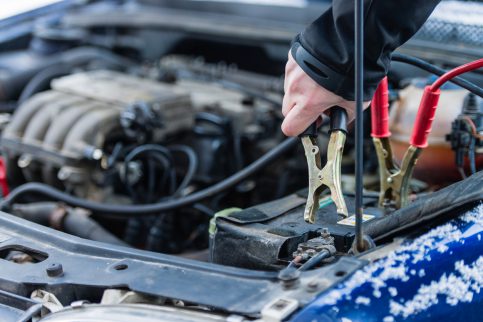By Lori Straus
You’re on the road to a winter getaway, it’s -25°C outside, the wind is blowing, and instead of driving, you’re stuck with a dead battery. What do you do? First, pull out your emergency kit and give everyone blankets, etc., to keep warm. Next, flag down a stranger to give you a boost. In this blog post, we’ll take you through the steps of boosting your dead battery.
A Few Words of Caution
Although most drivers are friendly and genuinely want to help, if you’re feeling nervous at all about asking a stranger for assistance, call roadside assistance instead. The general rule of thumb applies here: better safe than sorry. Also call roadside assistance if you and the person offering to help have never done this before: although the procedure is fairly simple, one small error can lead to a lot of damage.
Step 1: Park Your Cars Properly
Ensure your cars are close enough that the jumper cables will reach but not so close that your cars are touching in anyway. Then turn off the “helper” vehicle and make sure all passengers are at a safe distance away from the vehicles. Hopefully you have safety gloves and glasses with you. If you do, put those on before you start.
Step 2: Properly Connect the Batteries
As you connect the batteries to each other, ensure that the clamps do not touch one another. Pay attention to the order in which you need to connect everything. And last, check the batteries for any cracks, leakage, or corrosion before you start. If you see any kind of damage, do not proceed: jumping a damaged battery can—at worst—cause an explosion.
Connect one red clamp to the positive terminal on the dead battery (your battery). Then connect the other red clamp to the positive terminal on the booster car’s battery (the other person’s battery).
Next, connect the black clamp to the negative terminal on the booster car’s battery and ground the circuit by attaching the second black clamp to an unpainted metal peace on your car that’s as far away from the battery as possible.
Step 3: Turn on the Booster Vehicle
Turn on the booster vehicle but not your vehicle. Let the booster vehicle run for about five minutes before starting your car. If your car doesn’t start, don’t force the issue. Wait another five minutes and try again. If your car still doesn’t start, call roadside assistance for towing: there’s a good chance that there’s more wrong with your vehicle than just a dead battery.
Step 4: Keep Your Car Running for at Least 15 Minutes

If your car has started, congratulations! Do not disconnect vehicles right away, though, let them run together for another few minutes. When you’re ready to disconnect the vehicles, reverse the order that you connected them in. However, do not turn yours off: a battery recharge needs a running engine, so you’ll need to keep it running.
Drive your vehicle for at least 15 minutes, ideally to a location where you can get further help if required. Just because your vehicle has started once doesn’t mean that it will start again. If your freshly rebooted car doesn’t start after you’ve turned it off, call roadside assistance right away: you may need a battery replacement.
Safety First
A battery creates an electrical charge through the reactions of corrosive chemicals. If you’re at all nervous, contact roadside assistance. You’ll be happier you waited in the snow for a boost instead of a tow.


